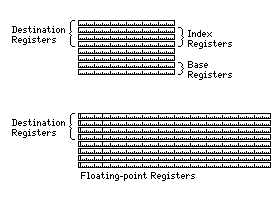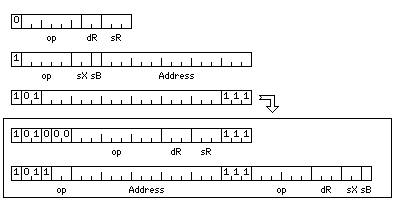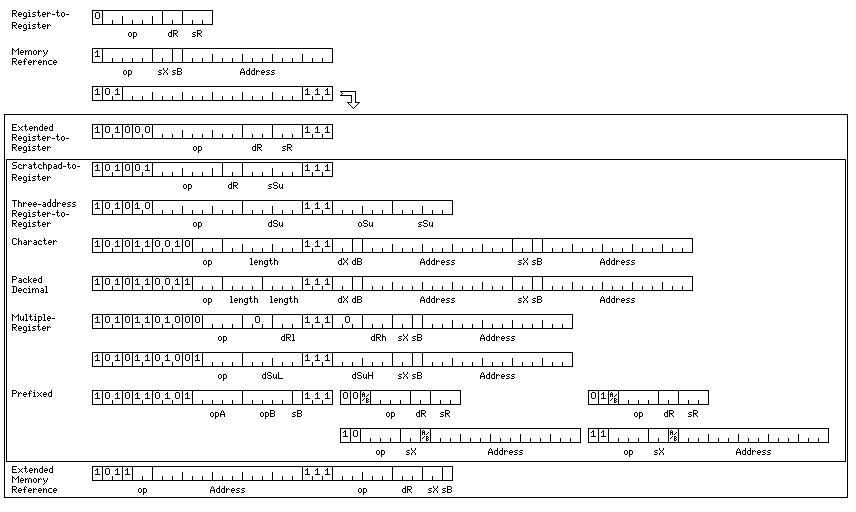
Originally, although an example architecture based on a fundamental unit of 12 bits was sketched out on the preceding page, I had declined to explore the possibility in detail. Now I will examine how a useful architecture might be built around instructions that are 12 and 24 bits in length.
The floating-point data formats that it will use would be the following:

The extended-precision floating-point numbers would be 96 bits in length, and this would also be a possible width for the data bus in this architecture; thus, some forms of data would face alignment restrictions based on power-of-two multiples of the fundamental unit.
The basic instruction formats would be the following:

Addresses, in this architecture, point to consecutive individual 12-bit units of memory.
This is based on organizing the registers of the machine as follows:

Thus, in a register-to-register instruction, to allow six bits for the opcode, and a bit to distinguish these instructions from memory-reference instructions, only the first four of the eight registers in each set can be used as the destination.
Note that this means that there will be a register-to-register form of the store instructions.
In the memory-to-register instructions, the destination register will always be register 0. As the base register field is only one bit wide, it indicates if register 6 or register 7 is used as the base register; zero does not turn off the use of a base register, but indicates register 6 instead. The index register field is two bits wide; 0 does indicate that an instruction is not indexed; 1, 2, or 3 indicates the integer register used as the index register.
Given that sizes of 36 bits and 60 bits are used for floating-point numbers, the opportunity for making use of alignment restrictions to conserve opcode space is limited. But as 24-bit and 48-bit integers, as well as 48-bit floating-point numbers, are used, some opportunity does exist, which is why the opcode field of the memory-reference instructions is only five bits long, while that of the register-to-register instructions is six bits long.
The basic register-to-register and memory reference instructons are as follows:
Register-to- Memory Register Reference 000000 00000 ... 0 SW Swap 000001 00001 ... 0 C Compare 000010 00010 ... 0 L Load 000011 00011 ... 0 ST Store 000100 00100 ... 0 A Add 000101 00101 ... 0 S Subtract 000110 00110 ... 0 M Multiply 000111 00111 ... 0 D Divide 001000 01000 ... 0 I Insert 001001 01001 ... 0 UC Unsigned Compare 001010 01010 ... 0 UL Unsigned Load 001011 01011 ... 0 X XOR 001100 01100 ... 0 N AND 001101 01101 ... 0 O OR 001110 01110 ... 0 ME Multiply Extensibly 001111 01111 ... 0 DE Divide Extensibly 010000 00000 ... 01 SWL Swap Long 010001 00001 ... 01 CL Compare Long 010010 00010 ... 01 LL Load Long 010011 00011 ... 01 STL Store Long 010100 00100 ... 01 AL Add Long 010101 00101 ... 01 SL Subtract Long 010110 00110 ... 01 ML Multiply Long 010111 00111 ... 01 DL Divide Long 011001 01001 ... 01 UCL Unsigned Compare Long 011010 01010 ... 01 ULL Unsigned Load Long 011011 01011 ... 01 XL XOR Long 011100 01100 ... 01 NL AND Long 011101 01101 ... 01 OL OR Long 011110 01110 ... 01 MEL Multiply Extensibly Long 011111 01111 ... 01 DEL Divide Extensibly Long 100000 00000 ... 011 SWE Swap Extended 100001 00001 ... 011 CE Compare Extended 100010 00010 ... 011 LE Load Extended 100011 00011 ... 011 STE Store Extended 100100 00100 ... 011 AE Add Extended 100101 00101 ... 011 SE Subtract Extended 100110 00110 ... 011 ME Multiply Extended 100111 00111 ... 011 DE Divide Extended 101000 01000 ... 011 MEUE Muliply Extensibly Unnormalized Extended 101001 01001 ... 011 DEUE Divide Extensibly Unnormalized Extended 101010 01010 ... 011 LUE Load Unnormalized Extended 101011 01011 ... 011 STUE Store Unnormalized Extended 101100 01100 ... 011 AUE Add Unnormalized Extended 101101 01101 ... 011 SUE Subtract Unnormalized Extended 101110 01110 ... 011 MUE Multiply Unnormalized Extended 101111 01111 ... 011 DUE Divide Unnormalized Extended 110000 10000 SWF Swap Floating 110001 10001 CF Compare Floating 110010 10010 LF Load Floating 110011 10011 STF Store Floating 110100 10100 AF Add Floating 110101 10101 SF Subtract Floating 110110 10110 MF Multiply Floating 110111 10111 DF Divide Floating 111000 11000 SWD Swap Double 111001 11001 CD Compare Double 111010 11010 LD Load Double 111011 11011 STD Store Double 111100 11100 AD Add Double 111101 11101 SD Subtract Double 111110 11110 MD Multiply Double 111111 11111 DD Divide Double
Because the extended format does not have a hidden first bit, unnormalized operate instructions are available for that format.
For integers, the Load instruction performs sign extension when the register is not filled; the Unsigned Load instruction zeroes the part of the register that is not filled, and the Insert instruction leaves that part of the register unaffected.
The Divide Extensibly instruction treats the destination register as a 48-bit quantity; that is divided by the 24-bit source operand, and the 48-bit result is placed in the destination register. The 24-bit remainder is loaded into the register at the next higher location - and the destination register for this instruction must be an even-numbered register.
The Divide Extensibly Long instruction can only have register zero as its destination register. Registers 0 and 1 together form a 96-bit integer (the most significant part of which is in register 0) which is divided by the 48-bit source operand. The 96-bit quotient is placed in registers 0 and 1, and the 48-bit remainder is placed in register 2 (not register 3, as a strict analogy with the Divide Extensibly instruction might suggest).
The Multiply Extensibly instruction multiplies the 24-bit source operand and the 24-bit destination operand, and puts their 48-bit product in the destination register.
The Multiply Extensibly Long instruction multiplies the 48-bit source operand and the 48-bit destination operand, and puts their 96-bit product in the destination register (which must be an even-numbered register) and the one following, with the most significant part being placed in the destination register.
The Multiply Extensibly Unnormalized Extended instruction places the most significant part of the product of its extended-precision floating-point operands in the destination register, which must be an even-numbered register, and the least-significant part of a double-width mantissa in the register following. The contents of the exponent field in that register are undefined, and should be ignored.
The Divide Extensibly Unnormalized Extended instruction divides a floating-point number with a double-length mantissa spread over two registers by the source operand; a quotient is produced as though the mantissas of the two operands were integers, replacing the source operand, and the remainder from this division is placed, in unnormalized form and with the correct exponent, in the second register following the source register.
The codes that would indicate an instruction operating on an aligned operand 192 bits in length or greater are instead used to permit additional instructions, both register to register and memory-reference.

In order to increase the size of the opcode field to eight bits for the memory-reference instructions, it was not possible to increase the size of the index register or base register fields in the instruction; this seemed reasonable, as making additional base registers available just for the extended-format instructions would have been of limited utility. However, a full three-bit destination register field was provided, as is the case for the extended register-to-register instructions.
In the register-to-register instructions, the opcode field is expanded to nine bits, rather than eleven, allowing additional instruction format options.
Seven bits are all that is required for the basic memory-reference and register-to-register instructions. These opcodes follow this pattern:
000nnnn (8 bits) Byte 001nnnn (12 bits) Small 010nnnn (24 bits) Integer 011nnnn (36 bits) Alternate Integer 100nnnn (48 bits) Long 101nnnn (96 bits) Extended 1100nnn (36 bits) Floating 1101nnn (48 bits) Medium 1110nnn (60 bits) Double
The types before Extended are fixed-point types. Multiply, Divide, Multiply Extensibly, and Divide Extensibly instructions are not provided for the 8 bit long Byte type.
The types after Extended are floating-point types with a hidden first bit, so no unnormalized floating-point instructions are provided for them.
Extended, on the other hand, is a floating-point type without a hidden first bit, so all the instructions shown above are available.
The extended memory-reference instructions are not required to be properly aligned. Alignment is still recommended, however, Thus, for Integer instructions, the last bit of the displacement should be zero; for Long and Medium instructions, the last two bits; and for Extended instructions, the last three bits.
It is envisaged that the data bus to main memory will be at least 96 bits wide, and, if longer, some power-of-two multiple of 96 bits.
To avoid crossing the boundaries of memory words with Floating (or Alternate Integer) numbers or Double numbers, one technique that is available would be to store them at a regular spacing of 96 bits, where each 96-bit memory word would contain one Floating number (36 bits long) and one Double number (60 bits long) in either order. Elaborations of this basic technique for computer architectures with different basic word lengths will be discussed later in this section, on this page.
The basic unit of memory in this machine is 12 bits long. Two of those units are 24 bits long, and three 8-bit bytes will fit into 24 bits. Thus, Byte instructions are regarded as aligned when the last bit of the address field is zero.
Only the first of three bytes in a 24-bit word can be addressed by such a memory-reference instruction in the absence of indexing. Note that a register-to-register Byte instruction operates on the least significant 8 bits of the registers involved, while a memory-reference Byte instruction operates on the byte in memory immediately at the address provided, thus in the most significant 8 bits of the 24-bit quantity addressed. This follows the general pattern of memory-reference instructions, since 12-bit and 24-bit quantities addressed by memory-reference instructions begin with the 12-bit memory cell actually addressed, rather than being in the last 12 bits or the last 24 bits of a 48-bit expanse of memory, in order to imitate the width of an integer register.
When an index register, 1, 2, or 3, is specified to be used with a Byte instruction, instead of providing a normal displacement in units of 12 bits, the displacement is in 8-bit bytes.
However, one byte in every 33 bytes is skipped in order to avoid the need to divide the index register contents by three in order to produce a conventional memory address that points to a 12-bit memory cell, or (after being shifted right three places) a 96-bit memory word.
33 bytes occupy eleven 24-bit words. If only 32 of them are used, then address generation can proceed as follows: the last five bits of the index register contents are used, basically, as an index into a table which indicates which byte of which 24-bit word is to be used, and the remainder of the index register contents are first shifted right five bits, and then multiplied by eleven to obtain a displacement in normal units of 24 bits (which can then be shifted left one bit to obtain a standard address in units of 12-bit memory cells, or shifted right two bits to obtain a physical address in units of 96-bit memory words).
This basic technique, as applied to putting 36-bit and 51-bit floating-point numbers in a 256-bit memory word, or as applied in the general case, will be discussed later in this section on this page.
There is enough opcode space to permit providing for other important types of instruction:

The prefixed instructions are designed to minimize the overhead of using types, such as 48-bit floating-point, not provided for in the basic register-to-register or memory-reference instructions; instead of lengthening each instruction by 12 bits, a single 24-bit prefix can provide for a large number of instructions.
Each instruction within the group of instructions so prefixed has a 4-bit opcode, indicating the operation it performs, and one bit to indicate which of two data types, A or B, applies. The first bit of the instruction distinguishes between 12-bit register-to-register instructions and 24-bit memory-reference instructions. The second bit is always zero, except in the last instruction in the sequence of prefixed instructions, indicated by it being a one. Because the normal opcode in a 24-bit memory-reference instruction is only five bits long, the choice of which base register to use for all memory-reference instructions in the sequence of prefixed instructions is made in the prefix.